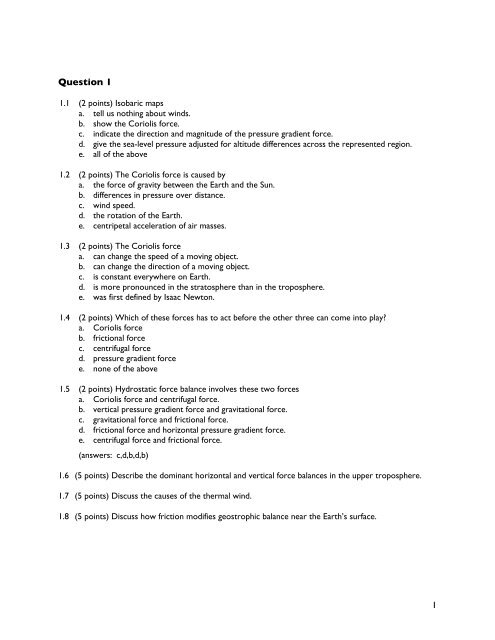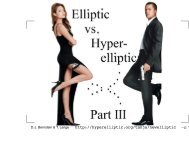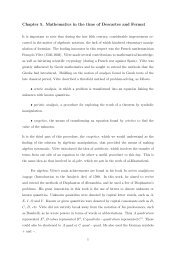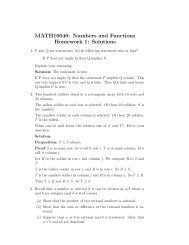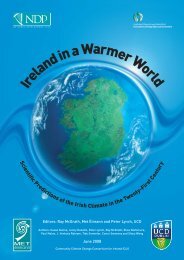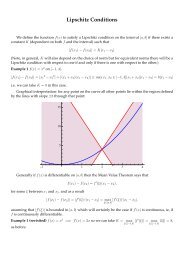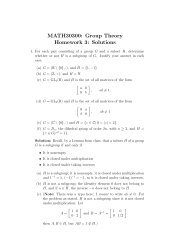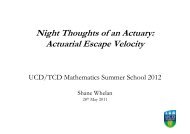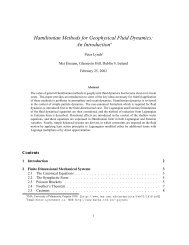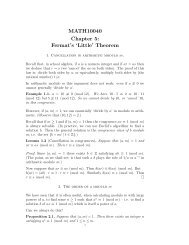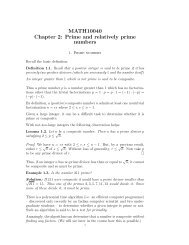Exam-like exercise set
Exam-like exercise set
Exam-like exercise set
You also want an ePaper? Increase the reach of your titles
YUMPU automatically turns print PDFs into web optimized ePapers that Google loves.
Question 11.1 (2 points) Isobaric mapsa. tell us nothing about winds.b. show the Coriolis force.c. indicate the direction and magnitude of the pressure gradient force.d. give the sea-level pressure adjusted for altitude differences across the represented region.e. all of the above1.2 (2 points) The Coriolis force is caused bya. the force of gravity between the Earth and the Sun.b. differences in pressure over distance.c. wind speed.d. the rotation of the Earth.e. centripetal acceleration of air masses.1.3 (2 points) The Coriolis forcea. can change the speed of a moving object.b. can change the direction of a moving object.c. is constant everywhere on Earth.d. is more pronounced in the stratosphere than in the troposphere.e. was first defined by Isaac Newton.1.4 (2 points) Which of these forces has to act before the other three can come into play?a. Coriolis forceb. frictional forcec. centrifugal forced. pressure gradient forcee. none of the above1.5 (2 points) Hydrostatic force balance involves these two forcesa. Coriolis force and centrifugal force.b. vertical pressure gradient force and gravitational force.c. gravitational force and frictional force.d. frictional force and horizontal pressure gradient force.e. centrifugal force and frictional force.(answers: c,d,b,d,b)1.6 (5 points) Describe the dominant horizontal and vertical force balances in the upper troposphere.1.7 (5 points) Discuss the causes of the thermal wind.1.8 (5 points) Discuss how friction modifies geostrophic balance near the Earth’s surface.1
Question 22.1 (2 points) Tropical cyclonesa. usually form at the equator.b. are strongest when they form over very warm waters.c. need cold ocean currents to trigger their formation.d. usually travel from west to east.e. are most common in the northern Pacific.2.2 (2 points) The weather in the eye of a hurricane is calm and clear becausea. low pressure exists directly above it.b. hurricanes are symmetrical.c. air is sinking there.d. the winds on both sides of the hurricane travel in opposite directions, and thus cancel eachother out in the eye.e. none of the above2.3 (2 points) If a typhoon is moving due west toward the Philippines at 10 m/s, the wind speed will beapproximately __________ on the north side of the typhoon than on the south side.a. 12 mph fasterb. 24 mph fasterc. 12 mph slowerd. 24 mph slowere. the same2.4 (2 points) The energy source of tropical cyclones is thea. latent heat of water.b. strength of equatorial winds.c. cold ocean currents near the western edges of continents.d. force of descending air.e. rotation of the Earth.2.5 (2 points) In the western Pacific, the most powerful storms are calleda. typhoons.b. tropical anticyclones.c. hurricanes.d. monsoons.e. tropical depressions.answers:(b,c,b,a,a)2.6 (5 points) Describe and explain the preferred locations for tropical cyclone formation.2.7 (5 points) Describe and explain the typical trajectory of a hurricane in the Atlantic basin.2.8 (5 points) Describe the internal structure of a tropical cyclone.2
Question 33.1 (2 points) After a warm front has passed, the air is usuallya. warmer.b. colder.c. drier.d. less stable.e. none of the above3.2 (2 points) Cold-front precipitationa. is confined primarily to the frontal zone.b. is long lasting.c. comes primarily from stratus clouds.d. all of the abovee. none of the above3.3 (2 points) The air that follows the passage of a cold front isa. colder than the air it replaced.b. the same temperature as the air it replaced.c. warmer than the air it replaced.d. much warmer than the air it replaced.e. none of the above3.4 (2 points) This would not typically happen with the approach of a warm fronta. pressure drops.b. thunderstorms.c. high clouds giving way to lower clouds.d. rising temperatures.e. rising dew points.3.5 (2 points) Strong surface convergence around a low-pressure system means thata. there is upper-level divergence.b. there is upper-level convergence.c. there is surface-level convergence from an associated anticyclone.d. there is upper-level divergence from an associated anticyclone.e. winds are weak in the area of the low-pressure system.(answers:a,a,a,b,a)3.6 (5 points) How can bodies of water affect an extratropical cyclone?3.7 (5 points) Describe and explain the typical weather associated with anticyclones.3.8 (5 points) Describe the main components of the Norwegian cyclone model.3
Question 44.1 (2 points) Oceansa. exchange energy with the atmosphere.b. transfer heat toward the poles.c. are a source of atmospheric water vapor.d. all of the abovee. none of the above4.2 (2 points) At which of the following latitudes does the atmosphere transfer more energy polewardthan oceans do?a. 25 degreesb. 40 degreesc. 50 degreesd. 60 degreese. 75 degrees4.3 (2 points) The Ekman spirala. is initiated by persistent surface winds.b. is unrelated to Coriolis force.c. only occurs in equatorial waters.d. results in subsurface water moving directly opposite to surface winds.e. all of the above4.4 (2 points) Ocean upwellinga. brings warm water to the surface.b. typically results in nutrient-poor surface waters.c. occurs along the coast of Northern California.d. requires poleward winds running parallel to the western coast of a continent.e. does not involve Ekman transport.4.5 (2 points) An El Niño event is triggered whena. the Pacific equatorial currents grow in strength.b. trade winds weaken or reverse direction.c. upwelling increases along the coast of Ecuador and Peru.d. ocean waters around Indonesia increase in temperature.e. La Niña is halfway through its cycle.(answers: d,a,a,c,b)4.6 (5 points) Draw a map showing the overall structure of surface flow in the world’s oceans, andidentifying the main currents.4.7 (5 points) Explain the causes and nature of Ekman transport.4.8 (5 points) What effects does El Niño have on the ocean, atmosphere, and global climate?4
Question 55.1 (2 points) When Columbus returned to Europe from the New World, he primarily took advantageofa. polar easterlies.b. midlatitude westerlies.c. northeasterly trades.d. southeasterly trades.e. none of the above5.2 (2 points) Over the course of a year, this would have the least cloud covera. equator.b. 7 degrees north.c. 30 degrees north.d. 40 degrees north.e. 50 degrees north.5.3 (2 points) Which of the following is not part of a Hadley Cell?a. subtropical jet streamb. trade windsc. ITCZd. subtropical highe. polar easterlies5.4 (2 points) When tropical air above the surface sinks at 20 to 30 degrees latitude ita. cools.b. helps form the trade winds.c. causes hurricanes.d. gives rise to high levels of precipitation.e. none of the above5.5 (2 points) The Indian monsoona. results in wet winters in the Himalayas.b. suppresses the orographic effect of the Himalayas.c. is caused by land’s ability to change temperature faster than water.d. has a land-to-sea surface pressure gradient in summer.e. all of the above(answers: b,c,e,b,c)5.6 (5 points) Discuss the formation of stationary planetary waves in the Northern Hemisphereextratropics.5.7 (5 points) Discuss 2 ways in which midlatitude atmospheric perturbations affect the climate.5.8 (5 points) Describe the role of angular momentum conservation in the formation of the subtropicaljet streams.5


